My entire life as an avid traveller I had never managed to get away during the Christmas holidays. For one reason or another, nothing ever lined up. Usually, it was because I had run out of vacation days in my work schedule by the end of the year. Or I had too many family obligations I couldn’t miss. But last year, with one of my good friends moving away to Sweden, I managed to cobble together enough days around the Christmas holidays to fly out to Stockholm! I had DREAMED of going to a European Christmas market for ages. Pinterest boards full of snowy timber huts lit by twinkle lights filled my imagination until I finally saw one for myself.
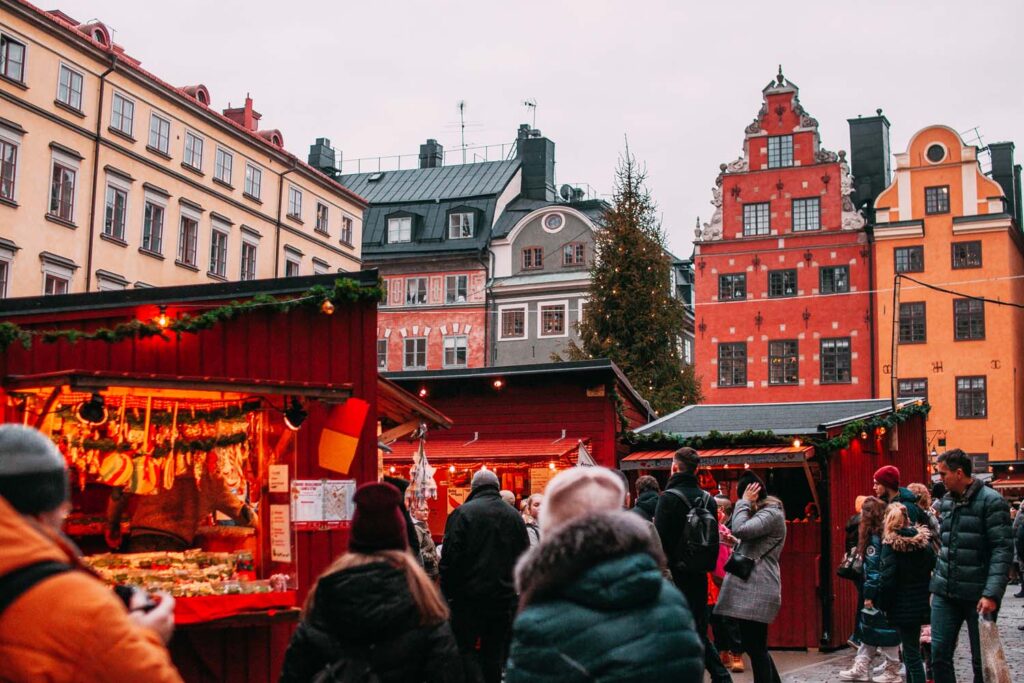
After an incredibly stressful journey to Stockholm, the next morning, when I awoke refreshed and excited, my friends and I all headed out to see my first European Christmas Market! There was so much to see and do, I was almost overwhelmed with all the different treats to sample, and charming Christmas souvenirs to bring home. So I wanted to create this guide to help you navigate all the various Christmas Markets to be found in Stockholm, the best things to buy while you’re there and, most importantly, what you need to EAT!
- Stortorget Julmarknad
- Skansen Christmas Market
- Christmas Market at Drottningholm
- The Christmas Market at the Royal Stables
- Bondens egen Marknad Östermalm
- Konstfack Christmas Market
- Christmas at Rosendals Trädgårdard
- Christmas Market at Färgfabriken
- Skeppsholmsgården's Christmas market
- Schysst Jul
- What to Eat & Drink
- What to Buy
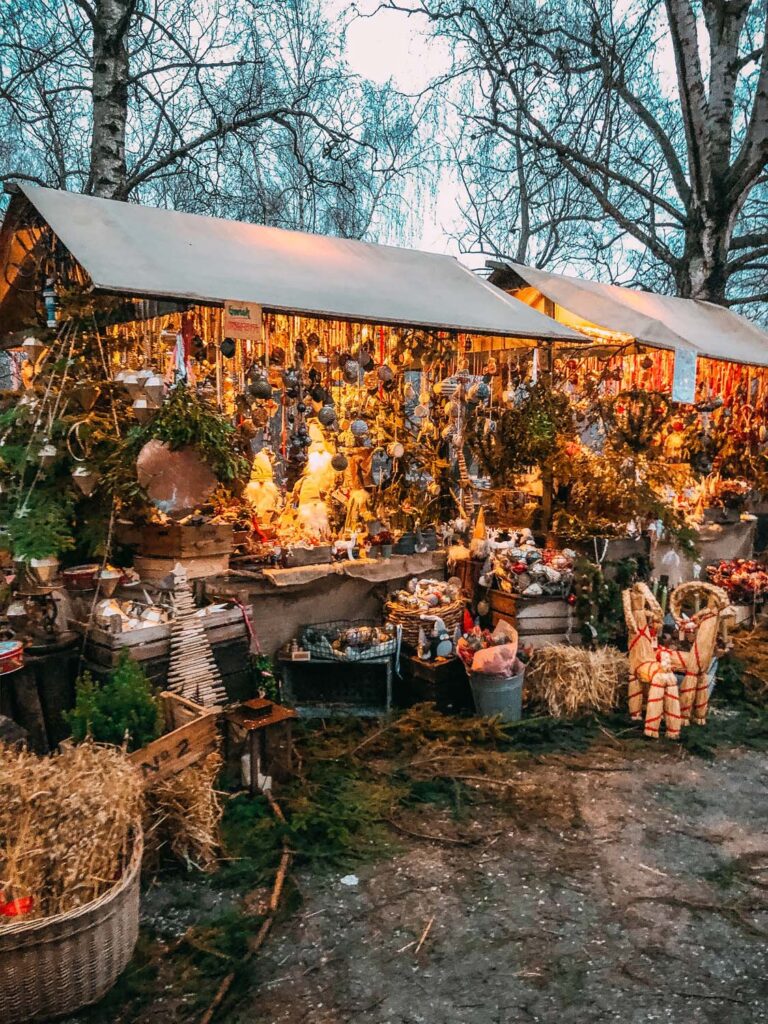
Stortorget Julmarknad
Located in the heart of Stockholm’s Old Town, Gamla Stan is the Stortorget Julmarknad. The Stortorget Julmarket is Sweden’s oldest Christmas market. Since this market feels like the original, I highly recommend you make it your first stop. It is by no means the largest, but there is something about its more modest size that makes it all the more appealing.
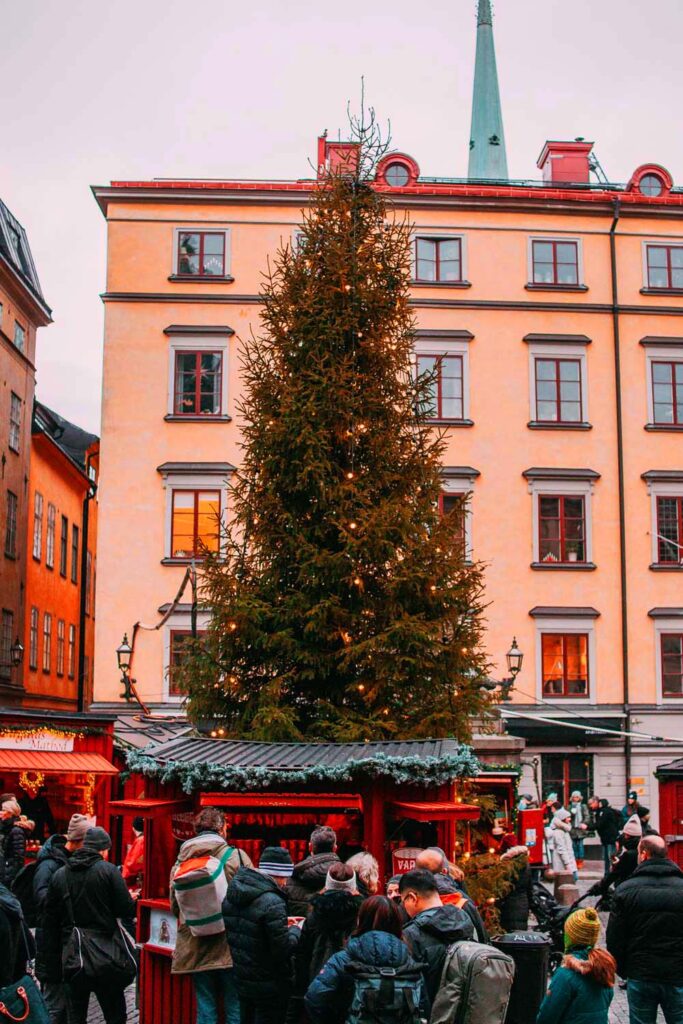
History
Farmer’s markets in Stortorget have been going on here since the 1300s, but the first Swedish Christmas market took place here in 1523. Back then there was only one Christmas market and its location would move around the city over the years. It wasn’t until 1837 that its place of permanence was established here, in Stortorget.
In 1915 the King of Sweden stipulated that only Swedish goods could be sold at this market, a tradition which the guild of markets still ensures is followed to this day. During the early days of the Stortorget Christmas market, you’d find tinsmiths, bookbinders, brush makers, glove and hat sellers, coppersmiths, pewter casters and jewellers. There was also a large swath of farmers who would travel long distances to sell their goods and produce here at the market. Despite the years going by and more modern production practices, many of the original items sold at the ancient market can still be found here today. Especially when it comes to food! The same 40 red wooden painted stalls pile themselves into the crowded square every year.
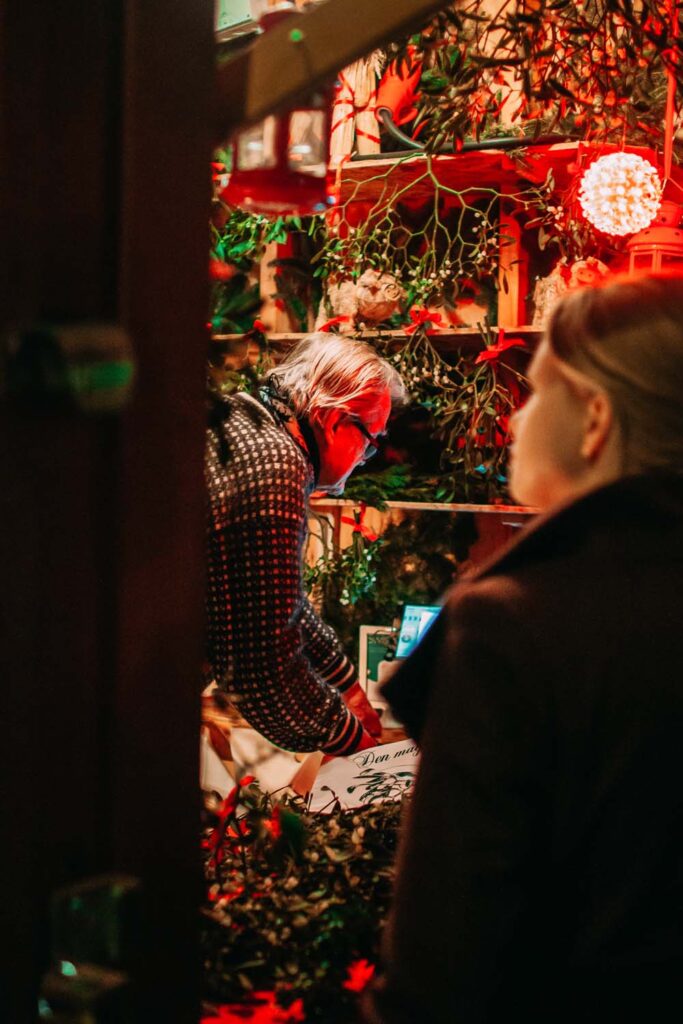
In the center of the red timber huts is the enormous Christmas tree. As far back as the 15th-century homes in Germany and Switzerland used spruce trees to decorate for Christmas. But it took a while for the trend to make its way to Stockholm. It wasn’t until 1920 that the first Christmas tree was raised here in Stortorget. But ever since, this beautiful tree has been a beacon for the market at the town square.
Open November 19th – 23 December 23rd 2022 | 11 am and 6 pm
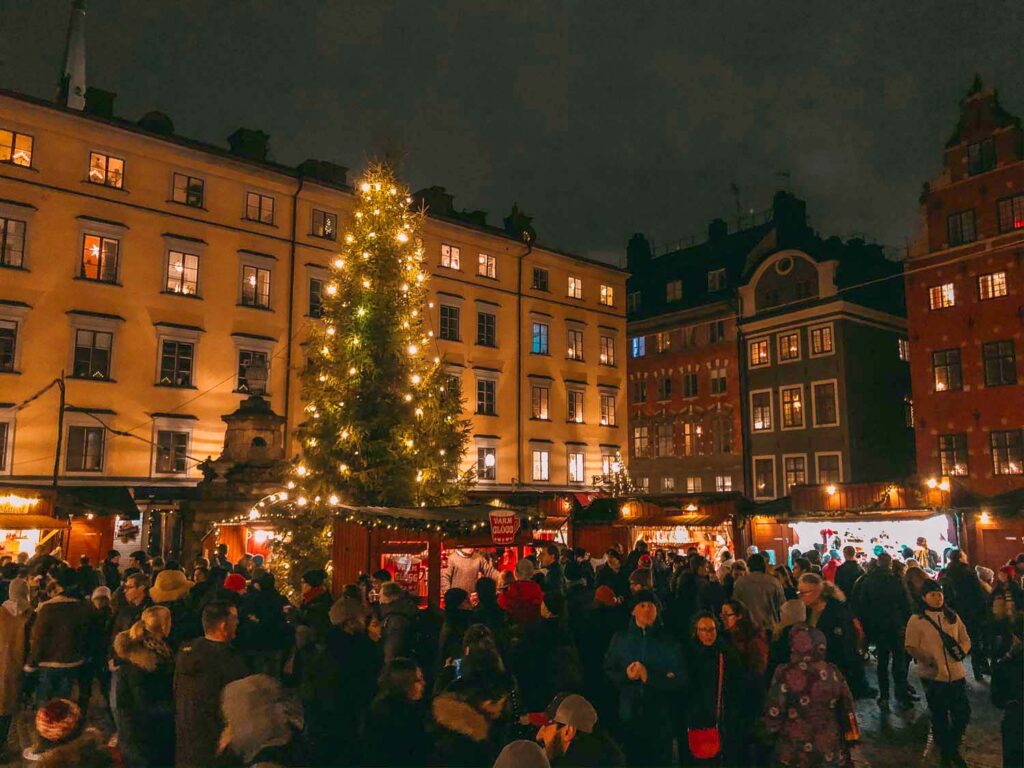
Skansen Christmas Market
Skansen is an open-air museum located in Stockholm, that depicts the Swedish way of life before the industrial era. It’s like stepping into a giant time machine. And at Christmas, entering the park is like walking into a Scandinavian fairy tale. Throughout the holiday season, Skansen is home to a variety of demonstrations depicting traditional Swedish Christmas celebrations.
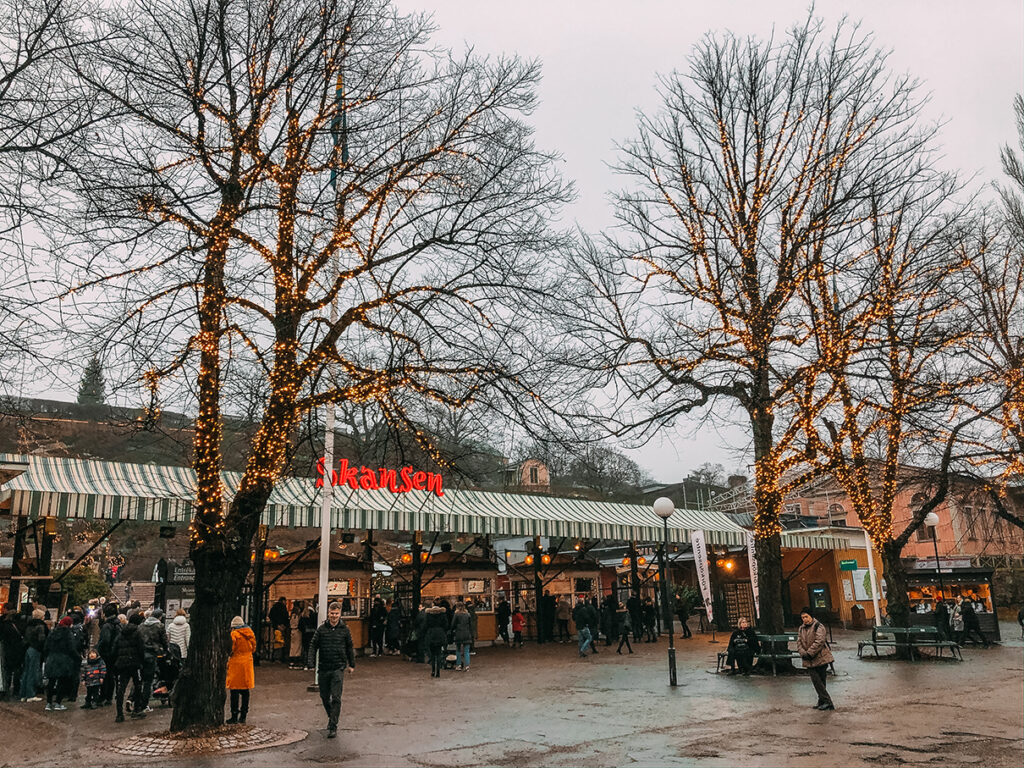
Christmas Activities
Try making your own Swedish ornaments, tour the historical houses and farmsteads decorated for the holidays and listen to musicians playing tunes inside. Go inside and talk with the housewives about what they fill their Christmas table for dinner with. And dance around the Christmas tree at Bollnäs Square!


Christmas Market
But the best part of the park is the old-fashioned Christmas Market. You’ll find dozens and dozens of stalls in the center of the park, surrounded by outdoor bonfires to keep you warm. If you’re hungry, you can sample their famous pancakes, classic reindeer sausages, Christmas cheese, crispbread and Skansen’s handmade mustard. To satisfy your sweet tooth, try the sugared almonds, honey, marzipan, saffron buns, pepparkakor (gingersnaps), homemade jams and marmalades, penny candy, and more!

Don’t forget to grab yourself a glass of Glögg, and Skansen’s specialty; Saffron Glögg. Suppose you’re looking for a little Christmas souvenir? In that case, there are hundreds of handicrafts, Christmas decorations, embroidery, hand-knitted mittens, and the iconic Swedish advent candles.
Open Friday, Saturday and Sunday from November 26th December 19th
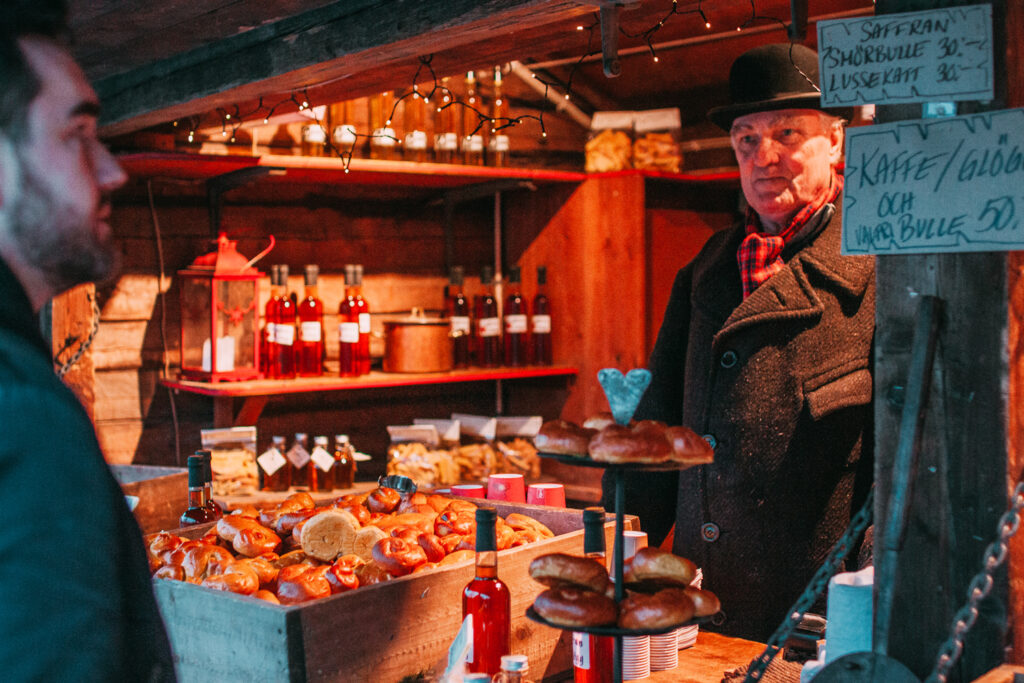
Christmas Market at Drottningholm
Drottningholm Palace is the private residence of the Swedish Royal family. It is located in Drottningholm, 40-minutes from the center of Stockholm. Although the Drottningholm Christmas Market is only open for two days in December, if you happen to be visiting Sweden during this time, it’s worth the effort to try and head down. The Christmas market is traditionally held in the palace grounds on the second weekend of Advent.
The Palace
During the winter, you can also tour the castle and see how Christmas celebrations took place in the 18th century! See how they kept the castle warm with no electricity, how candles were used to decorate the Christmas tree and even how the royals played games, put on theatre shows and spent their free time during the holidays. There is something so unique and regal about being invited to celebrate Christmas inside the royal palace. Talk to the various period actors throughout the castle, including skilled blacksmiths, candlemakers, straw weavers, and textile producers and see how Christmas presents were produced years ago.
The Market
The Drottningholm Christmas Market is also rather small, but very well curated. There are between 15 and 20 stalls. The outdoor market is filled with local produce with a festive flare featuring cheese, bread, mustard, fish, mulled wine and ham. You can find local craftspeople here selling handmade winter gear, warm slippers and Scandinavian embroidery and jewellery. There are even fun fair type games for the kids. Because the market is only open for two days, it feels all the more intimate and not so touristy. Not many tourists manage to make the trek or arrive on that day so you’ll find it feels more like a small-town affair.
Open December 3rd – 4th 2022
The Christmas Market at the Royal Stables
The Royal Stables are located just behind Strandvägen in Östermalm. Even today, the Swedish Monarchy uses ceremonial horses to transport them during state events and festive occasions. The Royal Stables, built in 1697, are open to the public throughout the year but by guided tour only. Inside, you can find around 50 horse-drawn carriages, sleighs and coaches, and 20, perfectly groomed and well behaved, royal horses. But during the Christmas season, a four-day market is held inside the stables. The market occurs over the first weekend of Advent. This is not only a great market to visit but a fantastic way of seeing the stables without booking a guided tour.
About 70 stalls on either side of an elegant red carpet are laid out inside the artful stables. The boothes feature handicrafts from all over Sweden. Some of the most unique gifts can all be found here all under one roof. You can even poke your head into the stables and say hello to one of the many royal horses. Don’t miss this market if you’re around.
Open November 25th – 27th 2022
Bondens egen Marknad Östermalm
Located in the quaint Tessinparken in the Östermalm is the Bondens egen Marknad, a weekly farmer’s market. And throughout December, they play host to a festive Christmas Market. This market feels more rustic and local. There aren’t as many handicrafts here, as the focus is more on local produce and Swedish food.
This is a fantastic place to come to buy a few items for a little picnic or “smorgasbord” back at your hotel. Cheese, sausage, bread and sweets, what more can you ask for! If you’re staying in town for an extended period of the holidays, pick up one of the hand-made pine wreaths to bring some of that Christmas scent into your hotel room. It’s the next best thing to a Christmas tree.
Open: December 3rd, December 10th and December 17th
Konstfack Christmas Market
If you’re looking for something a little different, check out the Konstfack University of Art and Design’s annual Christmas Market! Although the items here aren’t “Christmassy,” this is a glorious opportunity for you to support local artists by buying some of their ceramics, textiles, painting, jewelry, glass, posters, sculptures or decor. Plus, the entire event feels so festive. There is a small entrance fee, but even if you don’t buy anything, touring all the different works on offer is like walking through an art gallery. Their cafeteria is even open for guests during the event and serves up coffee and Christmas baked goods to all visitors. The market is open over the last week of November.
Christmas at Rosendals Trädgårdard
Rosendals Trädgård is a sprawling urban garden located in Djurgården, just west of Rosendal Palace. During the holiday season, a festive market pops up inside Rosendals Trädgårdard. Since it is a garden, one of the best things to buy here is their living Christmas arrangements. Huge wreaths and winter flowers will bring that unmistakable scent of Christmas into your hotel room or home! Their bakery is continually churning out bread, pastries and delicacies like fresh gingerbread which are made in their fantastic wood fire stone oven. This wood fire oven really adds a unique flavour to the baked goods and makes them taste like nothing else!
Their farm shop is in full swing, making pickles, jams and other exceptional items to eat while you’re in town or bring home to friends and family. Throughout the season, Christmas concerts featuring local musicians and composers fill the garden with sweet melodies. Walking around the garden stalls, under the fairy lights, lantern and bonfires is nothing short of magical and really gets you in the Christmas spirit! The Market is open from the end of November to the last few days before Christmas. Check their website for details.
Open November 18th – December 22nd
Christmas Market at Färgfabriken
Färgfabriken is a chich art gallery and event venue located in the Lövholmen suburb southwest of Stockholm. From December 10th to 11th Färgfabriken hosts its own Julmarknad, or Christmas Market, which boasts the honour of being Stockholm’s largest market for crafts and design. Inside you’ll find unique products from over a hundred exhibitors. In addition to these fantastic handmade products, you can also visit their cafe in the main hall, which serves up Christmas coffee, mulled wine, butter bread and other delicacies.
Open: December 10th – 11th 2022 | Admission is SEK 60 ($5.50 USD)
Skeppsholmsgården’s Christmas market
Skeppsholmen is a small, peaceful island located just east of Gamla Stan. It is frequently referred to as a museum island since it’s home to the National Museum Skeppsholmen, the Moderna Museet, the Swedish Centre for Architecture and Design and the Museum of Far Eastern Antiquities. But it is also home to the Skeppsholmen, a small sailing school that teaches sailing to children and young adults. But during December, Skeppsholmsgården hosts a small maritime-themed Christmas fair. The booths mostly feature nautical-themed handmade crafts; kids can even try out blacksmithing or watch the blacksmiths at work! Coffee and light food will be available for sale both in and outside.
Open: December 10th and 11th, 2022
Schysst Jul
Schysst Jul is a Christmas market, unlike the others. This market is focused on selling products that are all fair trade and organically produced. These businesses ensure all your Christmas gifts support the environment and the people who source and make the goods. This way you can feel good about what you’re buying.
Open December 3rd 10am-4pm & December 4 10am-3pm
What to Eat & Drink
Glögg
If you haven’t tried glögg at Christmas time in Sweden, you haven’t been to Sweden. Glögg is sweetened, mulled red wine blended with a spice mixture of cloves, cinnamon, cardamom and ginger. Different vendors might have their own unique spin on the drink with additives like citrus, raisins or almonds. It’s said to be lucky if you get a glass with one of the almonds in it. These nuts and fruits are sooooo good as they have soaked up all the flavour of the glögg and are a delicious little snack in your beverage. Glögg can be purchased by the glass at the market or you can even buy entire bottles to take home with you.
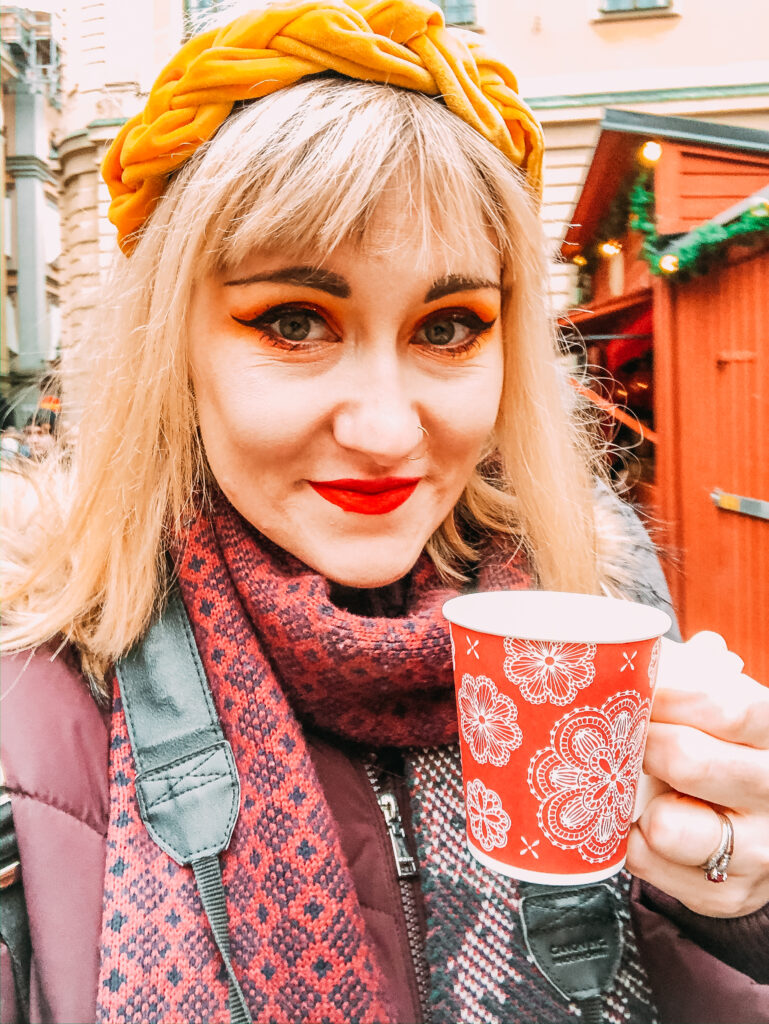
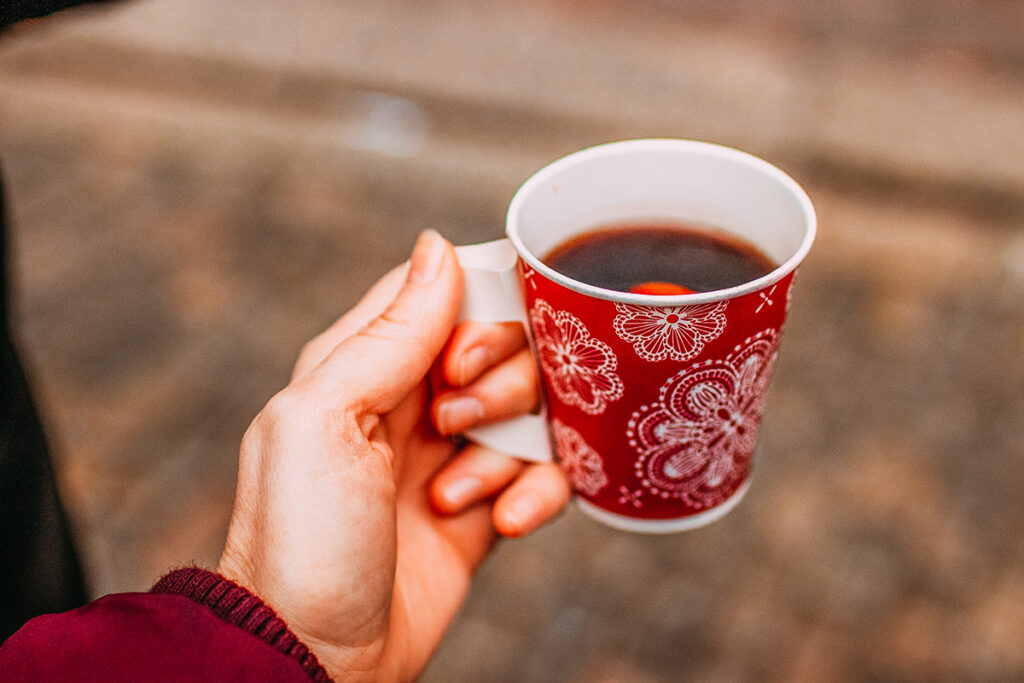
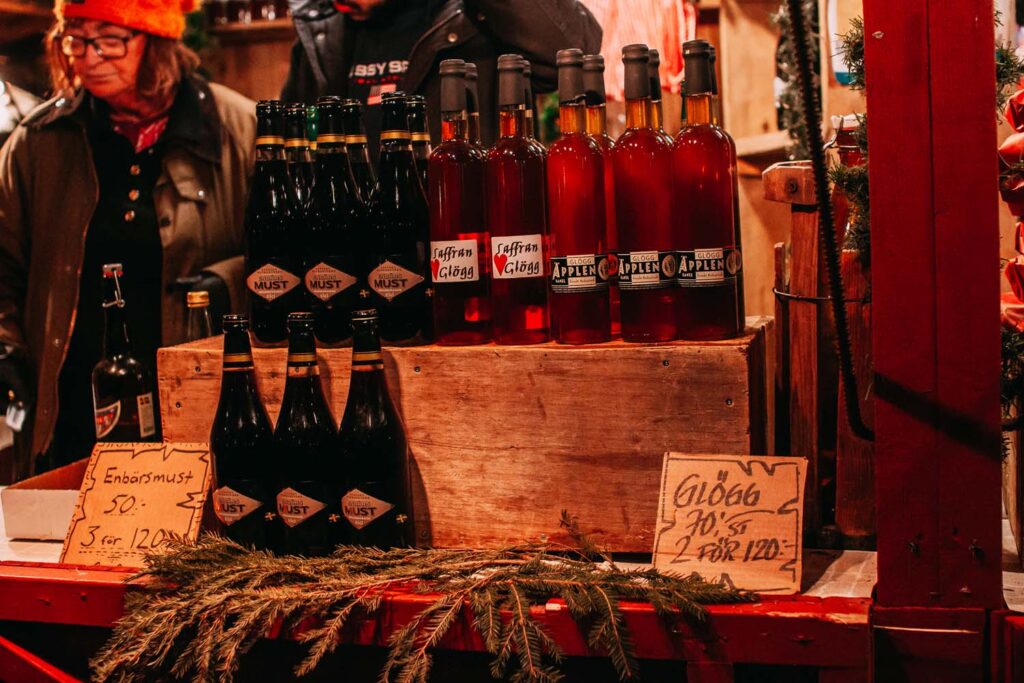
Pepparkakor
One of those Swedish Christmas treats I found everywhere in the city were Pepparkakor. Pepparkakor, or gingersnaps, have been eaten in Sweden since the the 1300s. But it wasn’t until the 1800s that it began to be associated with Christmas. You can find these delicious desserts made with gourmet ingredients in specialty cafes, sample traditional homebaked treats in the Christmas markets or just buy yourself an entire box inside the charming tins found on every shelf in the grocery store!
Unlike other gingersnaps I’d had before in Canada or even in the UK, these were SPICY! Not like temperature spicy but filled with spices. The cookies aren’t just overpowered by sweetness, they have so much real flavour. In fact, the reason they are called Pepparkakor is that they indeed contain pepper! I loooooved them. Their flavouring is almost so strong it could wake you up like a cup of coffee. They were even better dipped into a glass of glögg.
Although the cookies are eaten throughout the year, they are most popular at Christmas. Beautifully crafted tins and boxes of the cookies can be found at the market, and they make the perfect gift for those at home. You can also just buy one or two cookies to eat, dipped into your warm glögg while walking around the market.
Many Christmas markets also sell larger, non-edible versions of the cookie, decorated with brightly coloured icing sugar. The icing sugar spells out different Christmas greetings making them almost like a giant cookie Christmas card. These are great souvenirs and look adorable hung on the Christmas tree.

Saffransbullar
Saffransbullar or saffron buns are traditional pastries eaten during the Christmas season in Sweden. Their golden yellow and shiny appearance can be seen glimmering in windows of bakeries all across the county. The buns are made with saffron and dark raisins. They are rolled into an s-shape, which is said to resemble a cat all curled up, and the raisins used to denote the cat’s eyes. These warm buns are perfect for enjoying on a cold winter’s day or night. Although you might not bring these home, they are lovely to enjoy as you peruse the rest of the market.
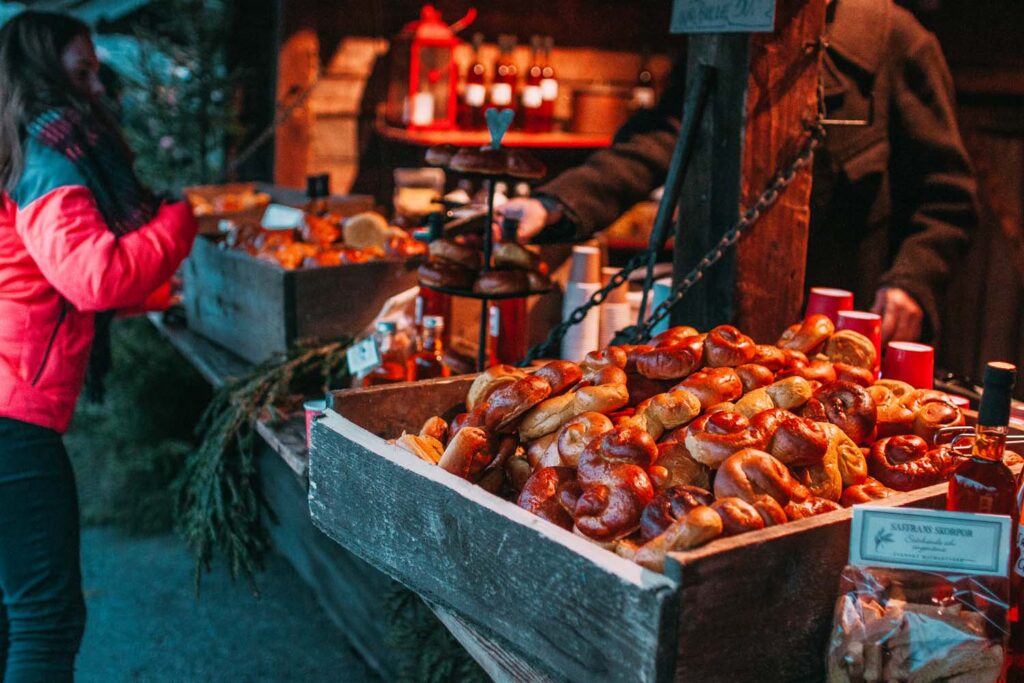
Smoked Meat
Smoked meat has been enjoyed by the Swedes since the dawn of time. But in Sweden, they specialized in various meats you might not have tried before. Specialties like elk, moose and reindeer. Prinskorv or “smoked sausages” are ALWAYS a part of the Swedish julbord or Christmas Buffet. While your home countries’ import restrictions might prevent you from bringing these foods home, they are a great thing to enjoy while you’re in town and are perfect for creating your very own julbord.
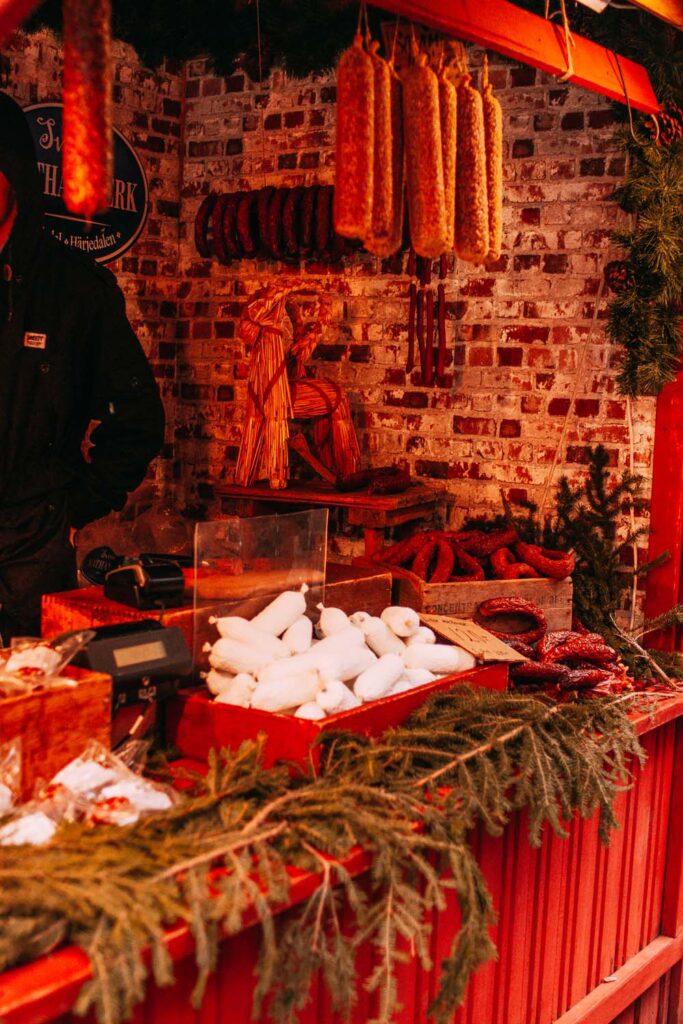
Knäckebröd
Another item to buy for your julbord is Knäckebröd or Swedish crisp bread. These dry crackers are HUGE, almost the size of a large dinner plate. They are usually made with rye flour, and although they are pretty delicate, the crackers can keep forever! At the Christmas markets, they are packaged in beautiful red Christmas wrapping paper and look like a gorgeous present under your tree.
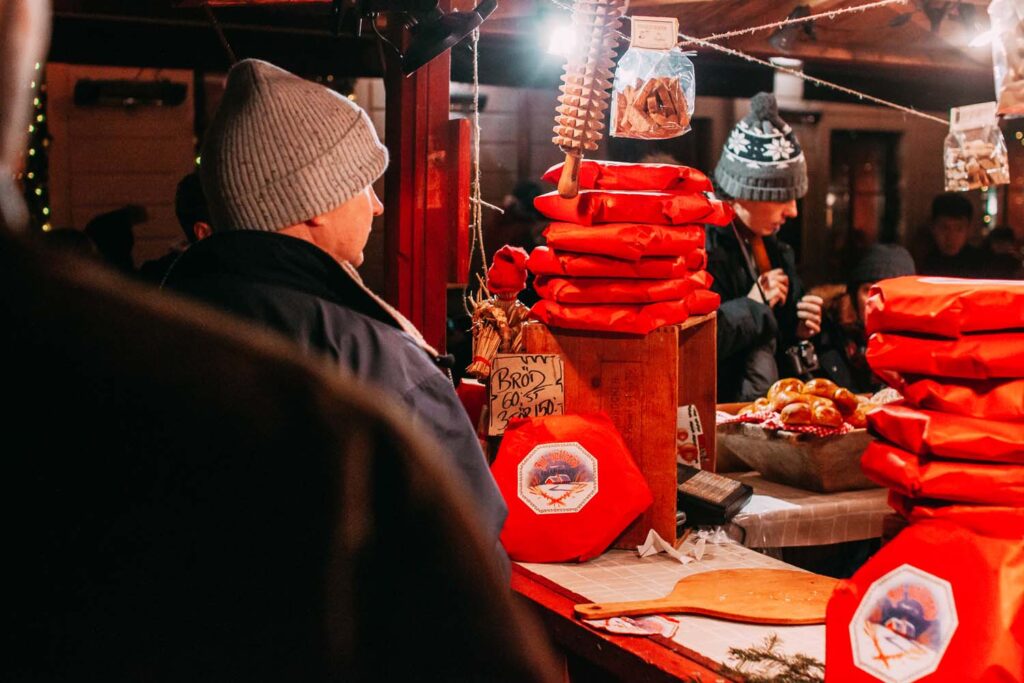
Polkagris
Although you might know them better as “candy canes” in Sweden, they are called ‘Polka Pig‘ or Polkagris. Polkagris was actually invented in Sweden around the 1800s. The name comes from the polka dance craze, which swept through Scandinavia at the time. The fast-paced dance matched the frenzied process required to create these twisted and twirled candies. These red and white peppermint sweets are made fresh for the market, but while they might look like the same thing you can get back home, I found they tasted much more refreshing and they had a more prominent punch!

Smågodis
While all the bins of candies might seem like a Christmas gimmick to get tourists to buy cheap candy for inflated prices, eating candy in Sweden is a real tradition. Smågodis means “little candies”. Visit any grocery store, convenience store or gas station and you’ll always find a series of bins filled with pick & mix candies. Take a bag and filler’ up!
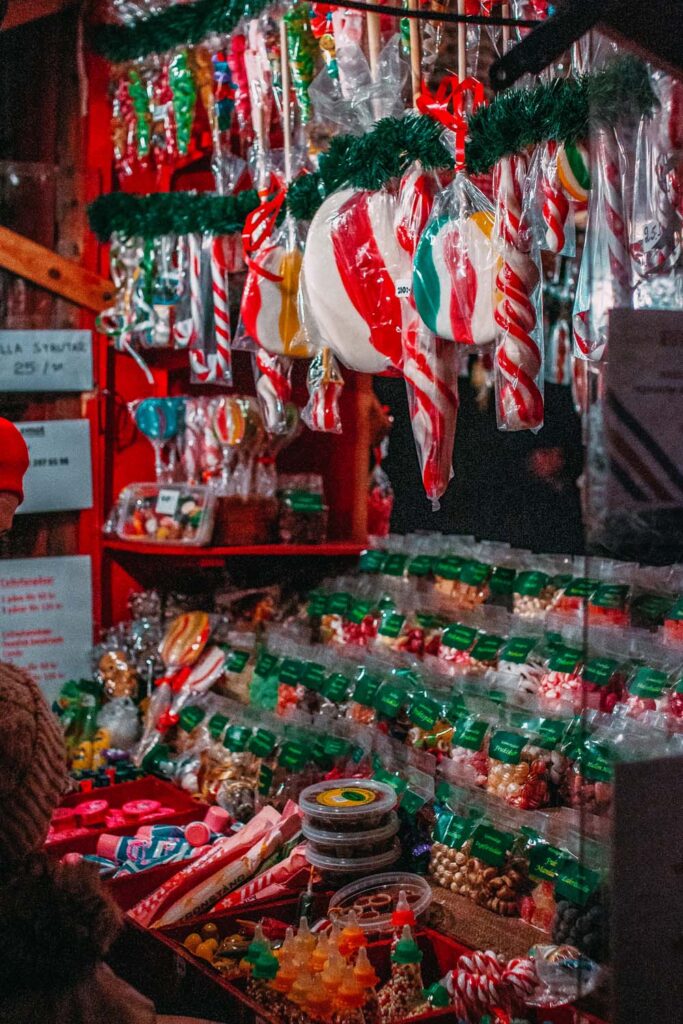
The tradition started as something called Lördagsgodis, meaning “saturday candy” in Swedish. Every Saturday, Swedish children were allowed to visit their local store and buy as much candy as possible. But the tradition locked itself in the heart of Swedes into adulthood. Today, the average Swede eats about 23 pounds of candy every year! And yet somehow they remain so slim….baffling. Christmas time is even more special when it comes to Smågodis, and filling your bag up in the marketplace is a great way to take part in this tradition, Saturday or not!
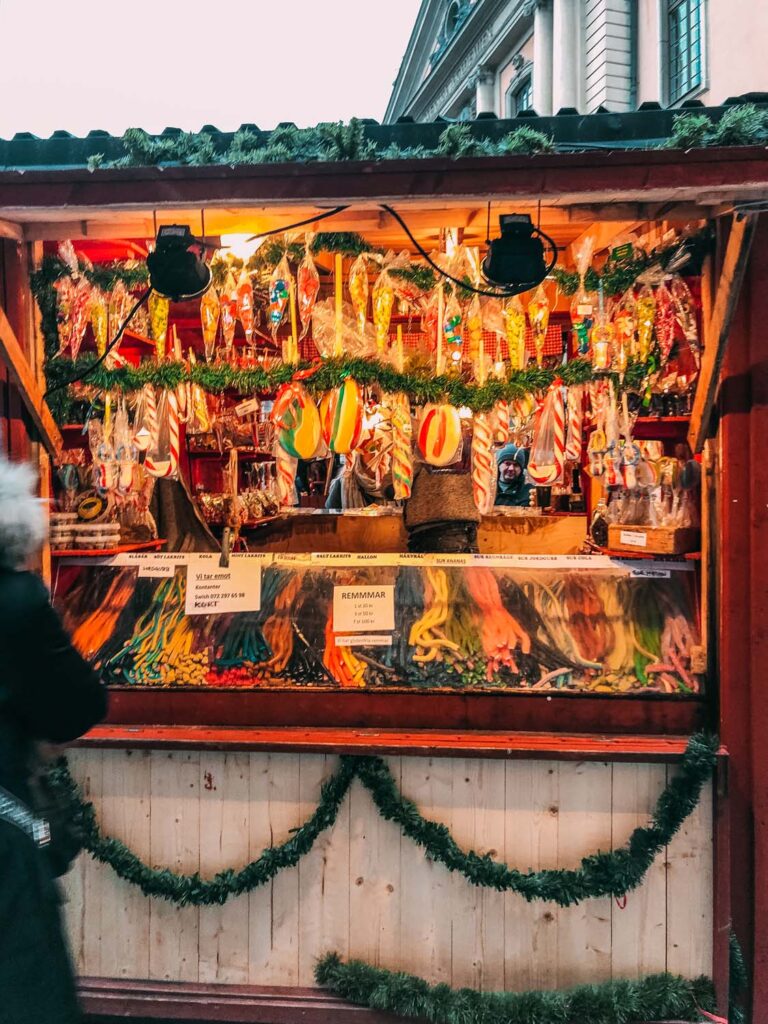
Brända mandlar
Brända mandlar or candied almonds are among the most intoxicating smells that draw you in throughout these market places. The steam coming off the hot pans wafts through the square. These freshly made almonds are a popular treat at Christmas markets, and a warm pack of them in your pocket keeps your hot all night long! Or…until you eat them up.
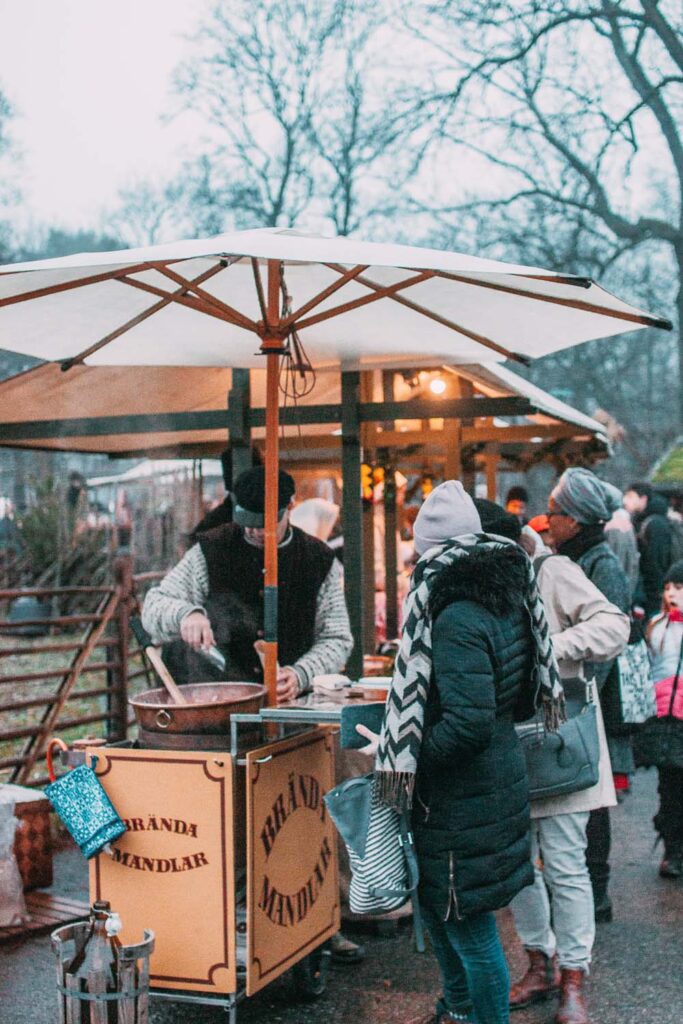
Ost
Another important aspect of the Swedish Julbord is cheese or as it’s called in Sweden, Ost! One of the most popular cheeses to eat during the holidays is Swedish Cheddar Cheese from Kvibille, Sweden’s best-known cheddar producer. Another popular variety is the Hushållsost made from cows milk. It’s the most popular kind of cheese eaten in Sweden, with 15,000 tons of it consumed every year.
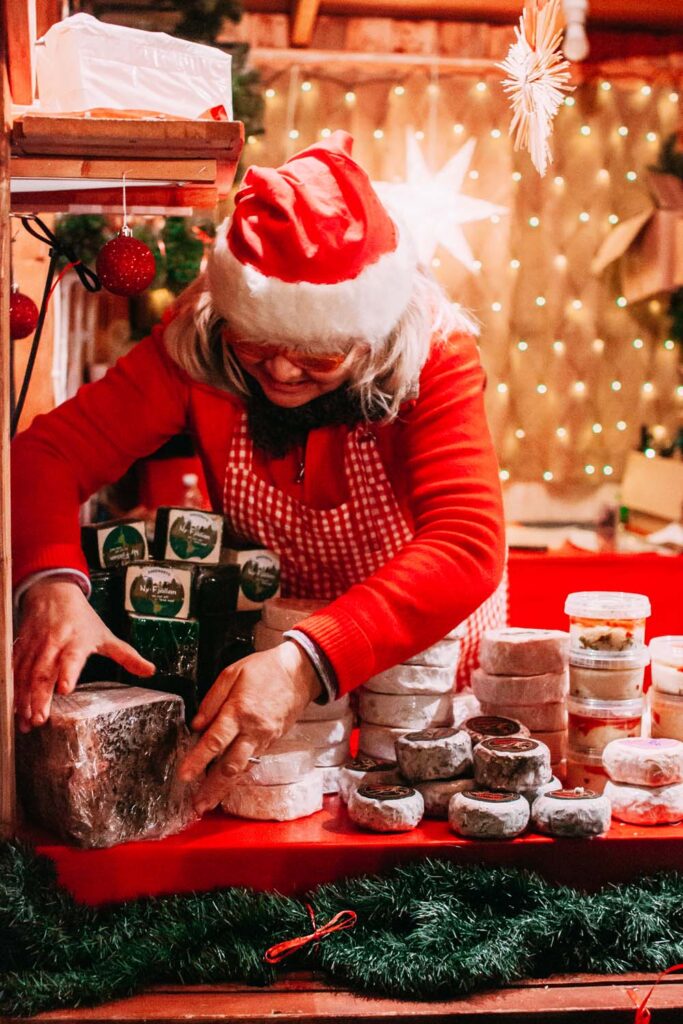
Swedish Mustard
Mustard is a popular condiment for the Swedes, they love to slather it on top of many different foods. At Christmas time, their festive ham isn’t complete without a side of hot mustard. But nothing compares to the homemade mustards you’ll find at local markets. These are fresh, spicy and a great gift (if you can keep your own hands off of it long enough)
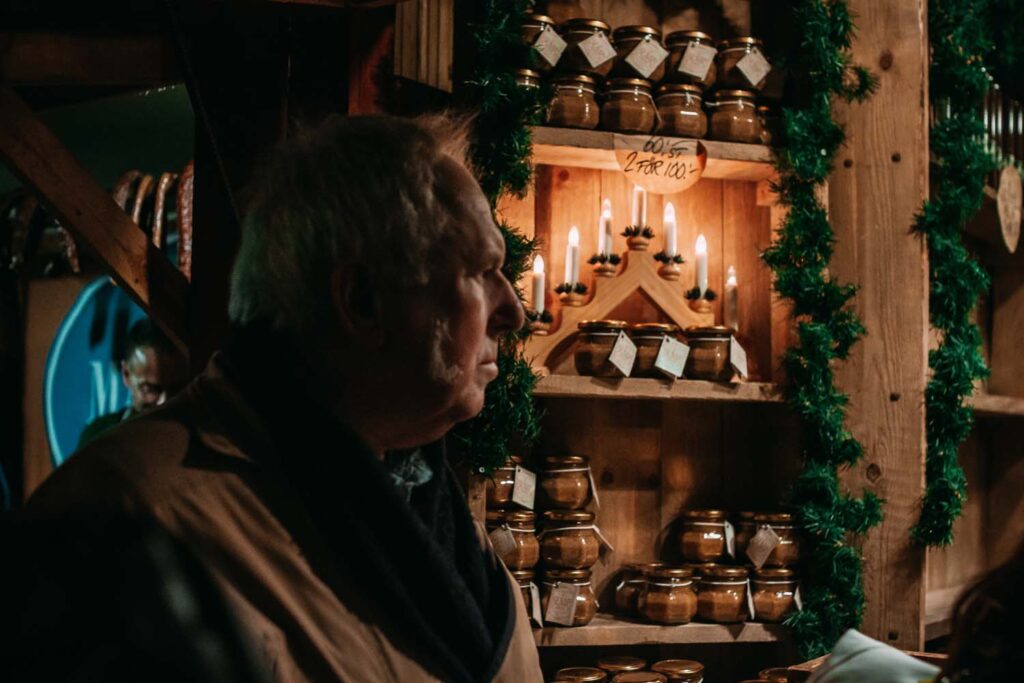
What to Buy
Julbock
One of the most iconic images of Christmas in Sweden is the Julbock. The Julbock, or Yule Goat, goes back to Sweden’s Pagan origins. Swedes worshiped the god Thor, who rode a chariot drawn by two regal goats. This cemented goats being seen by Swedes as vital beings ever since. In the 19th century, the Yule Goat’s role shifted to becoming the giver of Christmas gifts. It wasn’t until the 20th century that Swedes adopted the image of Santa Claus. Despite Santa becoming more and more popular, the Julbock is still a cherished Christmas decoration. These goats are made of straw and always feature a bright red ribbon. They come in all different sizes, from large table-sized versions to little Christmas tree ornaments. These are a must-buy for anyone visiting Sweden at Christmas time.
Christman Candles
Swedes love candles! It’s part of hygge. Hygge is the word for creating cozy and conformable spaces, which lead to a sense of wellness and contentment. Winters in Sweden get really cold and dark, and one of the best ways to combat the winter darkness is by lighting inviting candles throughout the home. Christmas candles in Sweden often feature five candles to represent the four Sundays leading up to Christmas with one candle in the middle for Christmas day. The most famous candelabras seen in windows all across Stockholm feature a stepped ladder design. These candles are so beautiful and would make a gorgeous centerpiece on the Christmas table.
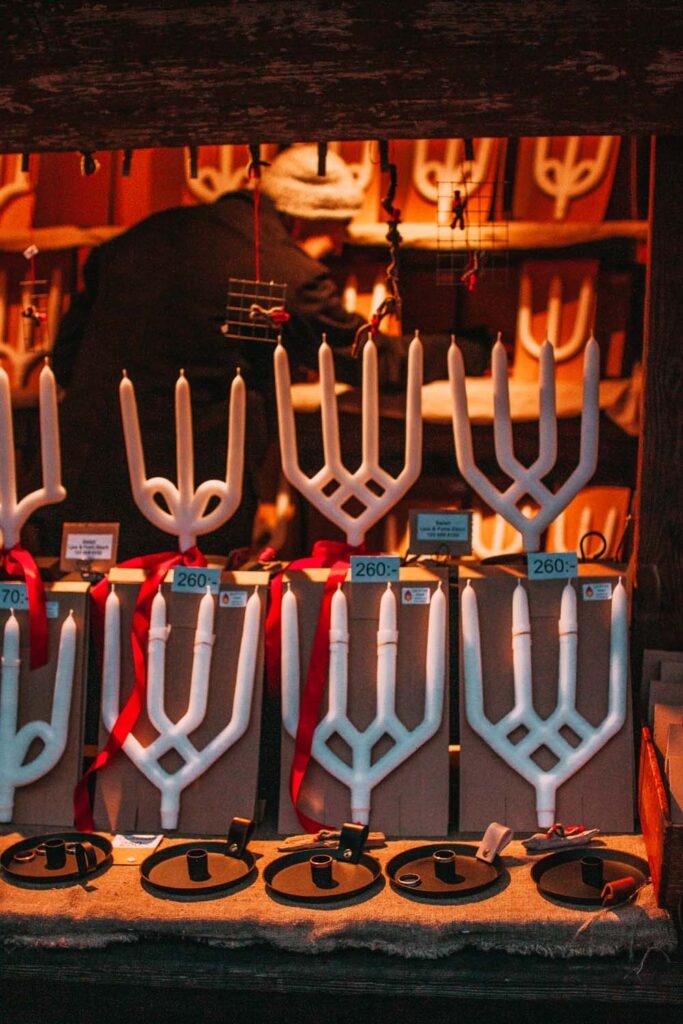
Tomte
Before the Swedes adopted Santa Claus, they had Tomte or Nisse. Tomte is a little forest gnome who is said to live under the house to protect children from misfortune. His defining features are his tiny stature, long grey beard, and large, pointed hat. The Christmas garb for Tomte features a bright red cap. At Christmas time, children leave out a bowl of porridge out for Tomte to ensure he creates no mischief. Tomte’s visage is replicated all over the market as hand-sewn felt decorations, sculptures, wooden figures, paintings and more. These make great gifts or an excellent addition to your own Christmas tree.
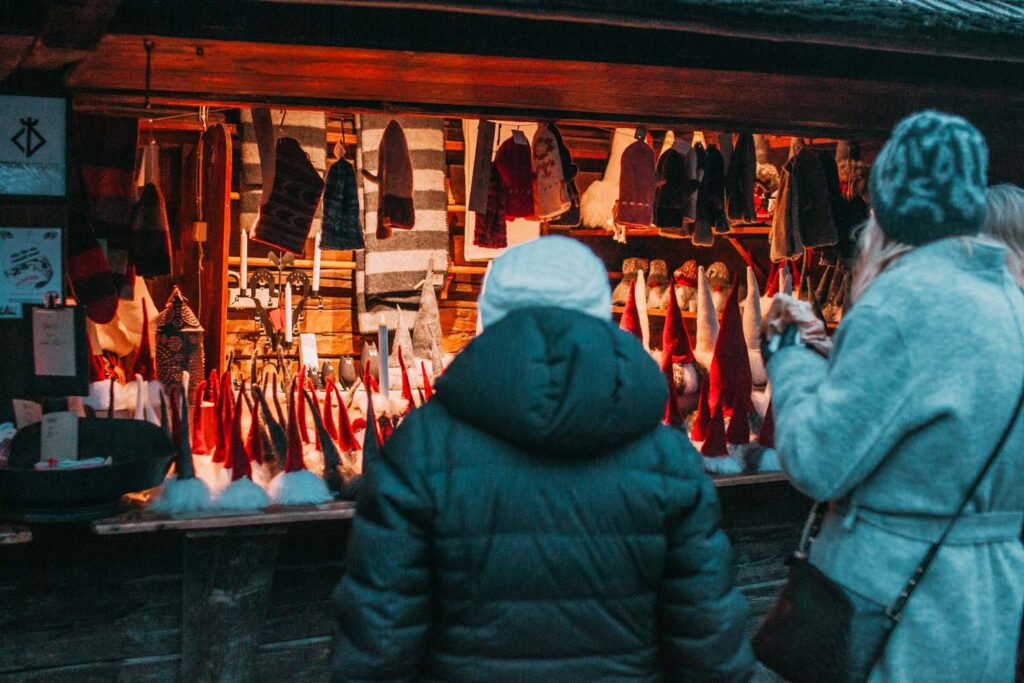
Julstjärna
The Julstjärna is the Swedish Christmas star. These paper decorations are seen hung in the home and in window frames all across the country. The shape of the Julstjärna resembles a Christmas poinsettia flower. These darling stars make any darkened room alit with the Christmas spirit! These stars are so famous they have even made it into the popular culture around the world and used year-round. Still, originally the stars were meant as a Christmas decoration and you can find amazing handmade versions in the marketplaces.
Lovikkavantar
Lovikkavantar are hand-knitted mittens originating from the village of Lovikka in northern Sweden. The exact pattern that is still made today dates back to 1892. It features a white and grey hand-knitted glove with yellow, blue and red embroidered tassels around the wrists. These are not only quintessentially Swedish, they are great for keeping your warm in the winter!
Dalahäst Ornaments
The Dalahäst or Dala Horse is a carved, wooden figure, originating from Dalarna, in the center of Sweden. Deep in the forests of Dalarna, during the long dark winters, farmers would use rudimentary tools to carve little horse toys for their children. Why horses, you ask? Well, perhaps for the same reason kids love to play with toy cars these days. Horses back then were one of the most essential parts of life. They transported you from place to place, helped plough fields, moved lumber, and of course, were a great animal companion.
The traditional designs of the Dalahäst features a bright red coat with an embroidered harness painted in white, green, yellow and blue around its neck. The Dalahäst is known to be a symbol for good luck. Many souvenir shops are known to sell Chinese mass-produced knockoffs which are anything but handmade or authentic. In fact, they use plastic which is heat wrapped around the wood to replicate the hand painted appearance. But in the Christmas markets which ensure only Swedish products are sold, you find mind authentically hand made one. They even have them in smaller sizes which are perfect to use as Christmas ornaments!
Kræmmerhuset
A Danish tradition that has made its way to Sweden is the Kræmmerhuset. These upsides down cones are Christmas decorations hung on the tree, which are then filled with candies. After Christmas is over, children are encouraged to help take the ornaments off the tree. As their reward they can eat the sweets they find within the Kræmmerhusets. The cones are often designed to resemble the shape of Tomte’s Christmas cap. This was such an exciting new tradition for me to discover and I was so excited to bring it home to teach my family!
Swedish Sami Jewellery
Sami jewellery comes from the northern Lapland region of Sweden. This Nordic handcraft is a form of indigenous jewelry passed down from generation to generation. The designs of Sami jewelry feature intricate braids made from silver threads. They are framed against a reindeer hide band. These simple but elegant styles are a beautiful gift and the perfect stocking stuffer!
Swedish Christmas Ornaments
Although it might seem redundant to mention buying Christmas ornaments at a Christmas market, I found the decorations for sale at these Swedish markets to be some of the most charming and adorable decorations I’d seen anywhere. It’s incredible how all of Sweden seems to have gotten behind the colour of Christmas decorations being only red, white and grey. Swedish Christmas decor is much more restrained and rustic. But they use a myriad of different materials which creates a gorgeous textural effect everywhere you look. There are glass-blown bobbles, wooden carved stars, hand-knit stockings, felt Santas, wheat shaped into snowflakes and more! You are sure to find the perfect complement to your Christmas tree anywhere you look.
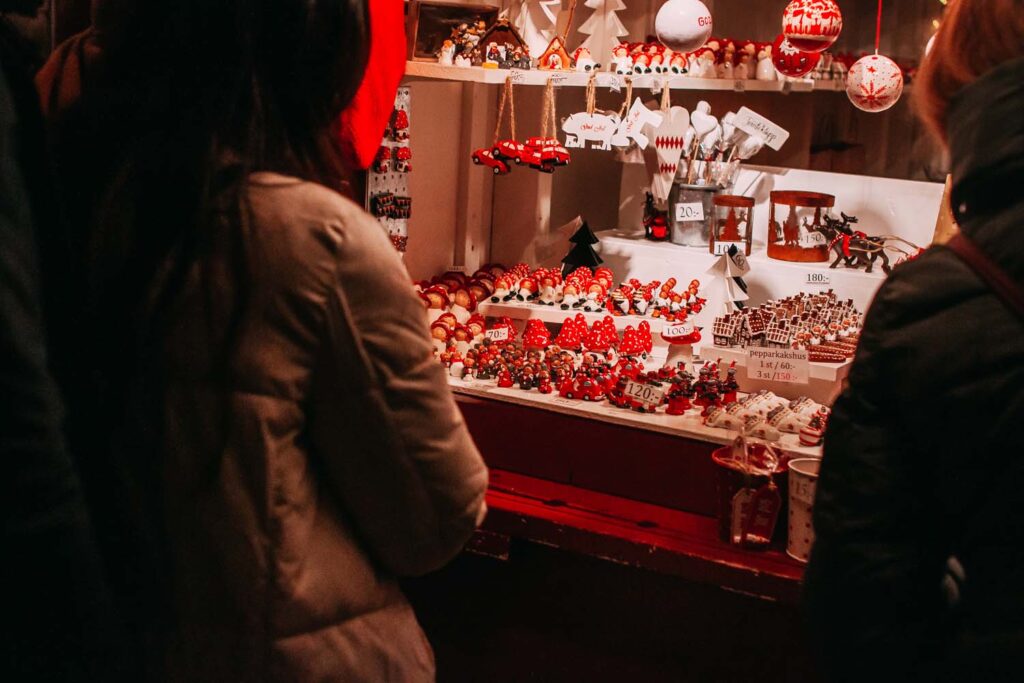
I had such a blast visiting the Swedish Christmas Markets. Even when I didn’t buy anything, it was such fun to just explore and look at all the wonderful things people had on display. The atmosphere at these markets is brimming with excitement and joy, and they are an experience not to be missed.
Let me know in the comment if you’ve ever visited a European Christmas Market before and where was your favourite!
Happy Travels Adventurers
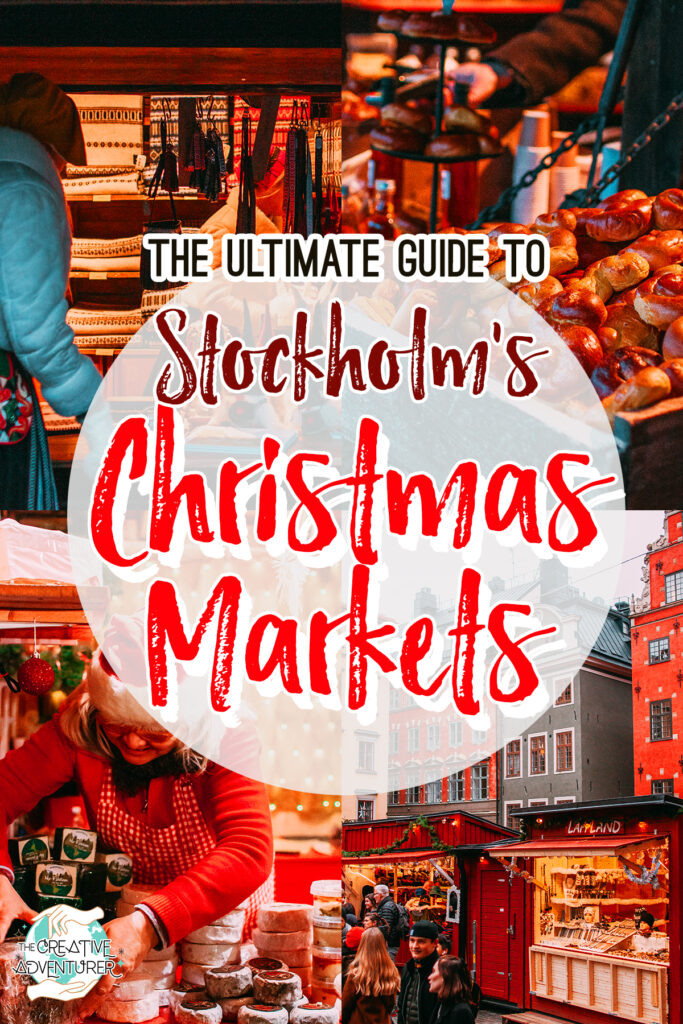
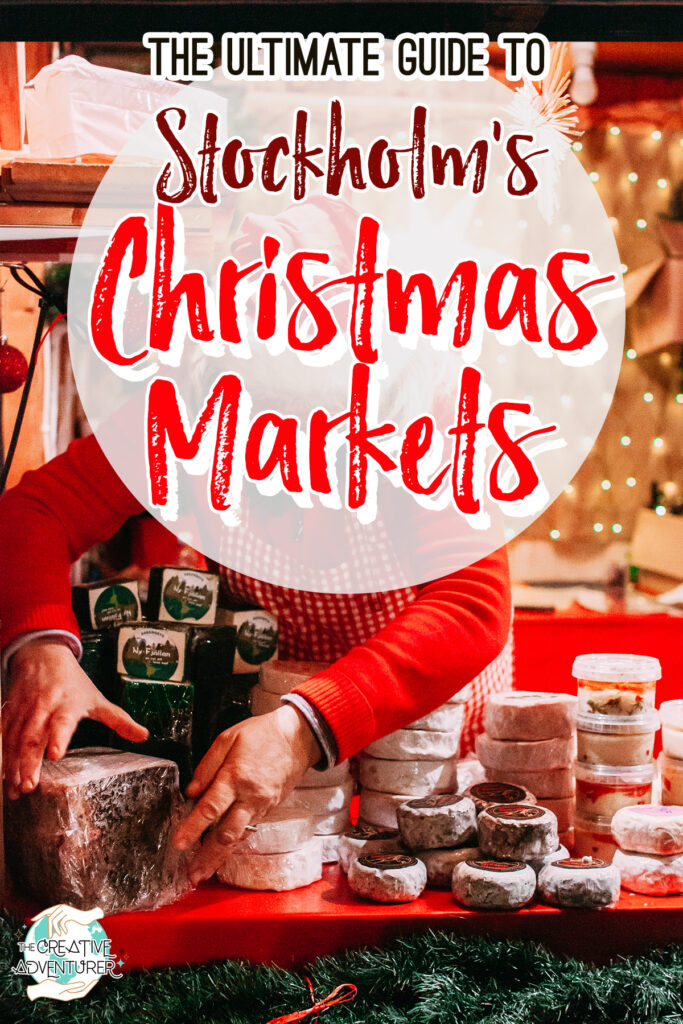
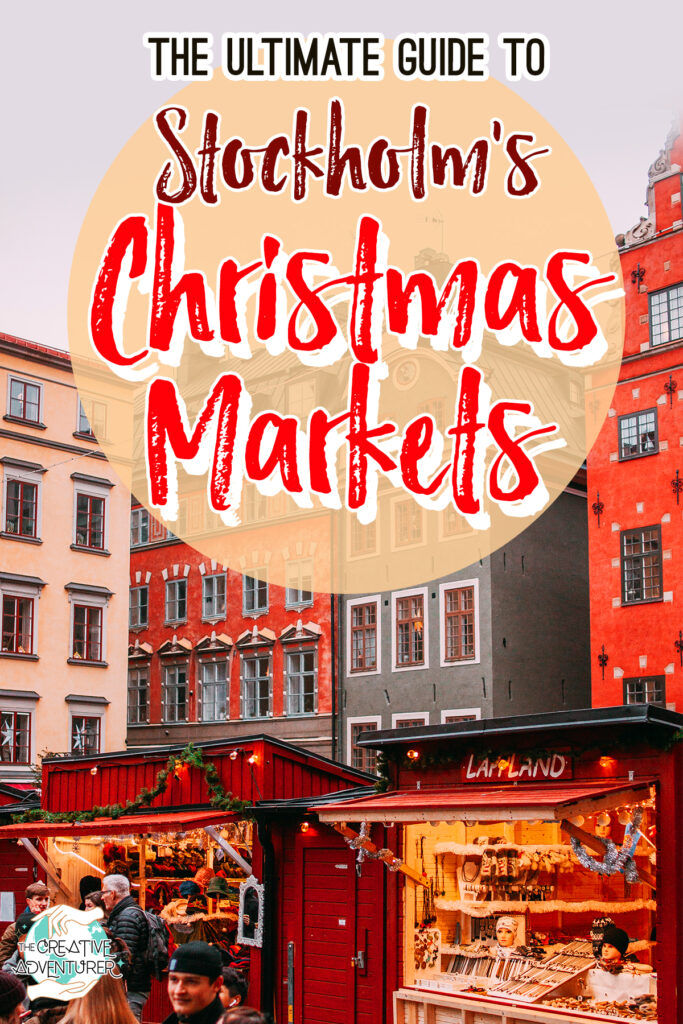
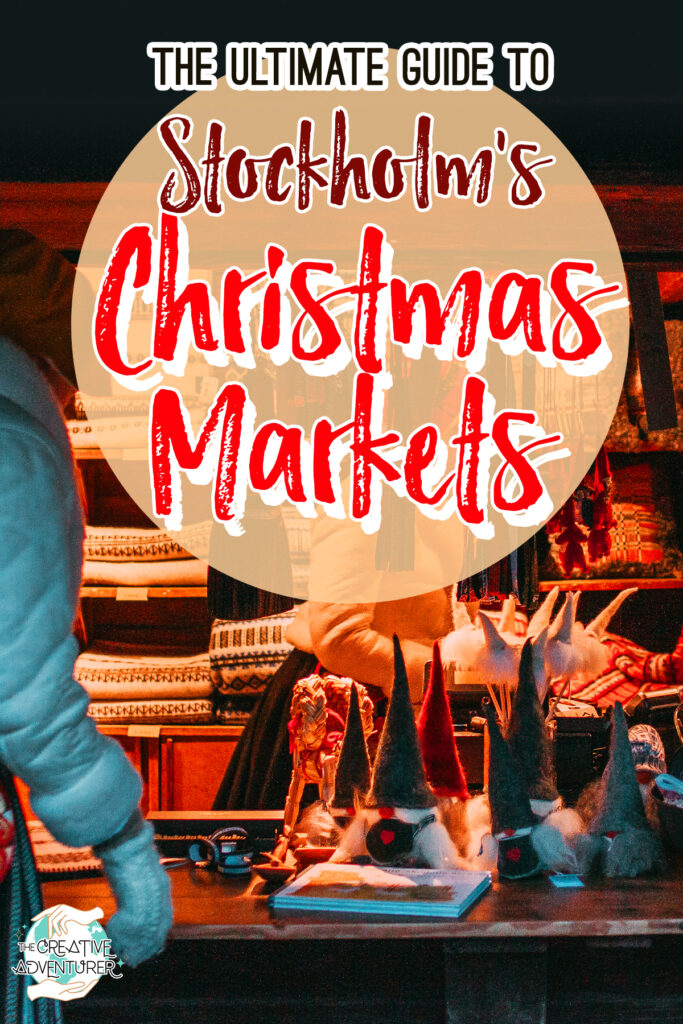
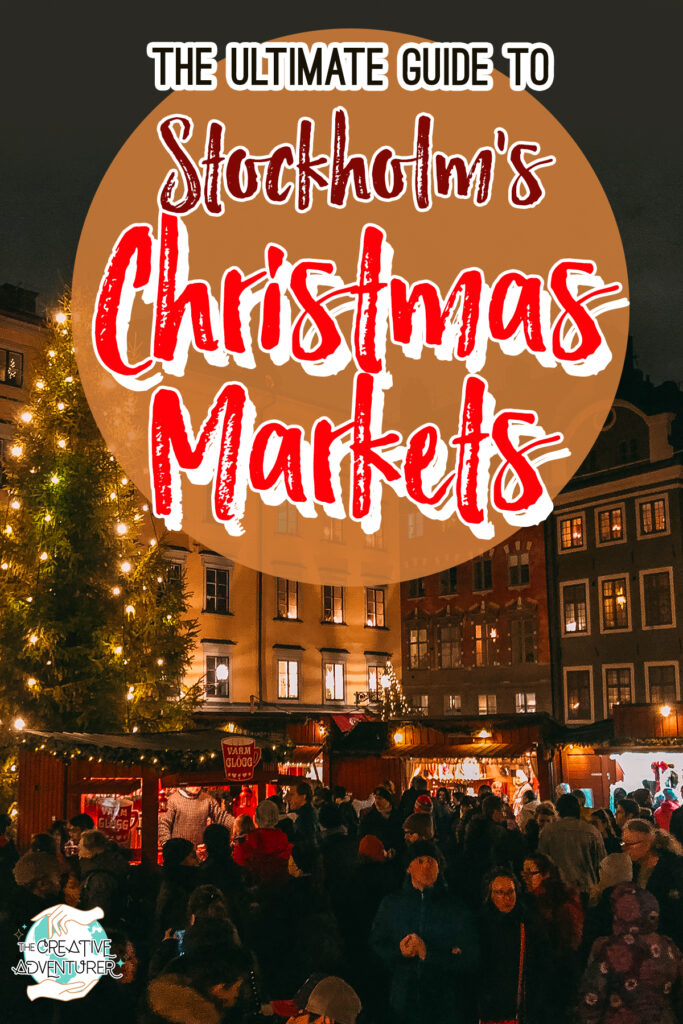



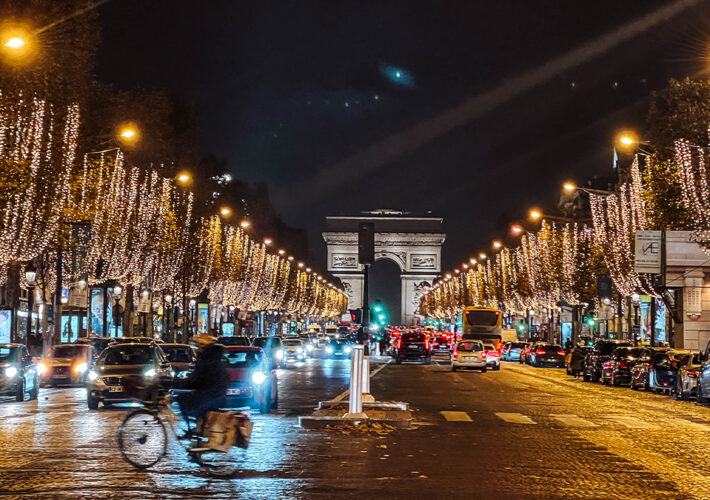
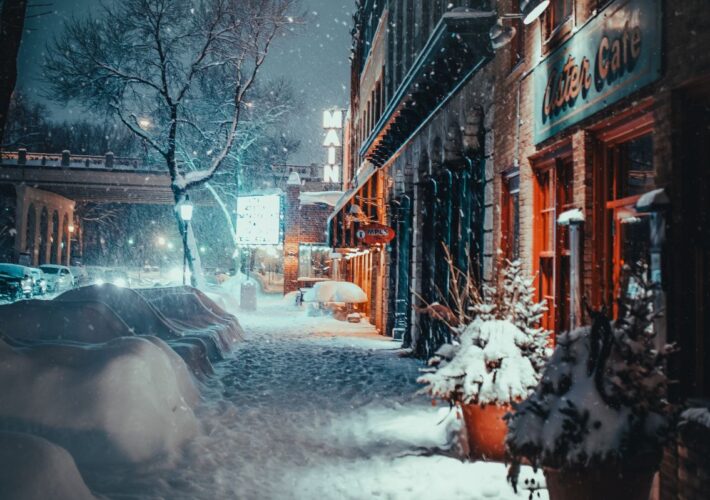
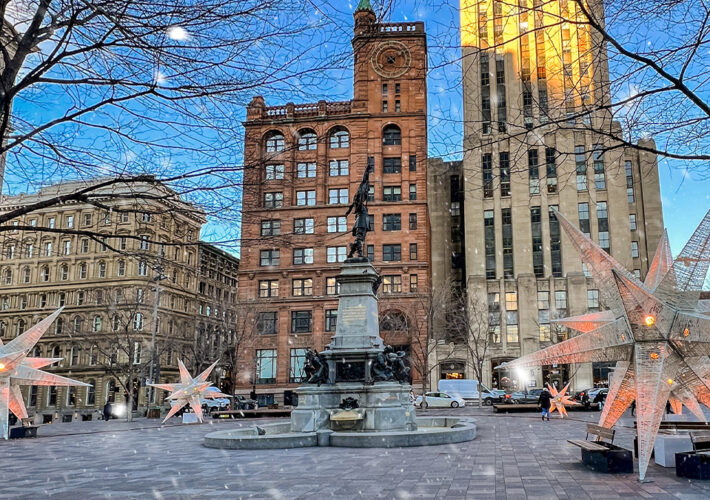
Leave a Comment